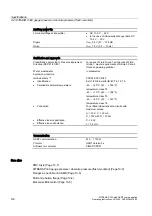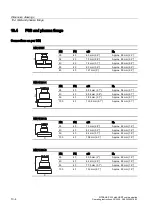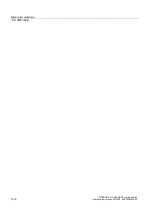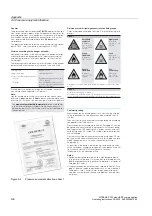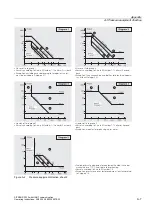
Appendix
A.3 Pressure equipment directive
SITRANS P300 with HART communication
A-6
Operating Instructions, 06/2005, A5E00359579-02
General
The pressure equipment directive
97/23/EC
applies to the align-
ment of the statutory orders of the European member states for
pressure equipment. Such equipment in the sense of the direc-
tive includes vessels, pipelines and accessories with a maxi-
mum permissible pressure of more than
0.5 bar
above
atmospheric.
The pressure equipment directive can be used starting Novem-
ber 29, 1999, and is compulsory starting May 29, 2002.
Division according to the danger potential
Equipment is divided in line with the pressure equipment direc-
tive according to the danger potential (medium/pressure/vol-
ume/nominal diameter) into the categories I to IV or Article 3
Paragraph 3.
The following criteria are decisive for assessment of the danger
potential, and are also shown in Diagrams 1 to 4 and 6 to 9:
Fuelled pressure equipment or equipment heated in another
manner are shown separately in Diagram 5.
Note:
Liquids according to Article 3 are those liquids whose steam
pressure is
not
more than
0.5 bar
above standard atmospheric
pressure (1013 mbar) at the maximum permissible temperature.
• Fluid group
Group 1 or 2
• Aggregate state
Liquid or gaseous
• Type of pressurized equipment
- Vessel
- Pipeline
Product of pressure and volume
(PS * V [barL])
Nominal diameter, pressure or
product of pressure and nominal
diameter (PS * DN)
The
maximum permissible temperature
for the used liquids
is the maximum process temperature which can occur, as
defined by the user. This must be within the limits defined for
the equipment.
Division of media (liquid/gaseous) into the fluid groups
Fluids are divided according to Article 9 into the following fluid
groups:
Conformity rating
Pressure equipment of categories I to IV must comply with the
safety requirements of the directive and be assigned the CE
symbol.
They must comply with a conformity rating procedure according
to Appendix III of the directive.
Pressure equipment according to Article 3 Paragraph 3 must be
designed and manufactured in agreement with the sound engi-
neering practice SEP applying in a member country, and must
not be assigned a CE symbol (CE symbols from other directives
are not affected).
Siemens has carried out a conformity rating, assigned a CE sym-
bol, and issued a declaration of conformity for its products (pro-
viding the equipment is not within the context of Article 3
Paragraph 3).
Supervision of the design, dimensioning, testing and manufac-
ture is carried out according to module H (comprehensive qual-
ity assurance) by the TÜV Nord (Northern Technical
Inspectorate) as the specified office.
Notes:
• Equipment designed for media with a high danger potential
(e.g. gases of fluid group 1) may also be used for media with a
lower danger potential (e.g. gases of fluid group 2, or liquids of
fluid groups 1 and 2).
• The pressure equipment directive according to Article 1 Para-
graph 1 does not apply to equipment such as e.g. mobile off-
shore plants, ships, aircraft, water supply and waste water
networks, nuclear plants, rockets and pipelines outside indus-
trial plants.
Group 1
Potentially
explosive
R phrases:
e.g.: 2, 3 (1, 4,
5, 6, 9, 16, 18,
19, 44)
Highly toxic
R phrases:
e.g.: 26, 27, 28,
39 (32)
Highly
flammable
R phrases:
e.g.: 12 (17)
Toxic
R phrases:
e.g.: 23, 24, 25
(29, 31)
Readily
flammable
R phrases:
e.g.: 11, 15, 17
(10, 30)
Fire
stimulating
R phrases:
e.g.: 7, 8, 9
(14, 15, 19)
Flammable if the maximum permissible temperature is above the flash
point.
Group 2
All fluids not belonging to Group 1.
Also applies to fluids which are e.g. dangerous to the environment, cor-
rosive, dangerous to health, irritant or carcinogenic (if not highly toxic).
Figure A-1
Pressure equipment directive, sheet 1

